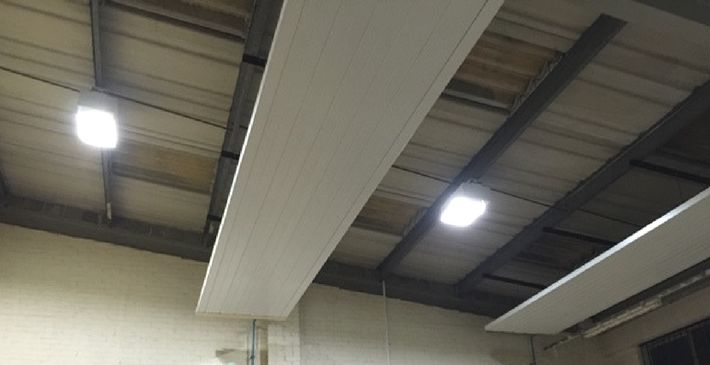Spirit’s warehouse adjoins the warehouse of Primrose, the online gardening retailer. Our unit is full of solar panels, inverters, batteries, LED lights and exciting things like that. Their unit is full of garden furniture, water features, awnings, wind spinners and all of the exciting things available at www.primrose.co.uk.
Earlier this year we were called in to upgrade the metal halide lights to LED.
Why?
In a nutshell, the insurers weren’t happy with the fire risk presented by metal halide lights. More on this below.
Happily, we were able to show that this wasn’t the only reason that Primrose should be upgrading its warehouse lighting. As well as reducing the fire risk, replacing metal halide lights with LED high bays will cut the company’s lighting bill by 60%. Primrose expects to save a further 20% by installing a motion sensor with each fitting… We also checked compliance with the updated emergency lighting standard (BS5266: 2016).
What’s more, for SMEs (small and medium enterprises), the Green Business Fund will cover up to £5000 of the project cost, so that payback times typically come in at around 2 years. This compares to an expected life for the lights of 20 years…
What is a metal halide light and why does it present a fire risk?
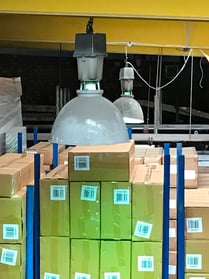 |
 |
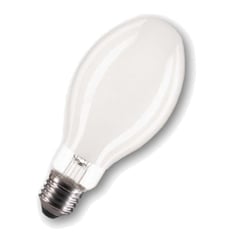 |
The pictures show a typical metal halide light fitting, and the typical elliptical metal halide bulb that screws into the fitting.
These lights operate at very high internal temperatures and pressures, which can lead to catastrophic failure if the light is damaged, or at end-of-life.
When the lamps break, extremely hot fragments fall to the ground, with the potential to land either on combustible materials, setting fire to the place, or on a worker, causing serious burns/injury.
Hence the concern of the insurance company…
Metal halide LED replacements
Most warehouses and industrial work places with metal halide high bays use 250W to 400W bulbs.
As with most LED upgrades there are two ways to convert to LED:
(1) replace the bulb only, using an LED corn bulb:
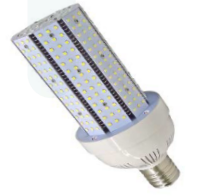
The ballast on the existing fitting will need to be bypassed, thus connecting the LED high bay replacement bulb (which has its own in-built ballast) direct to the mains.
(2) replace the entire fitting, usually with something that is sometimes referred to as a UFO LED high bay, for obvious reasons:
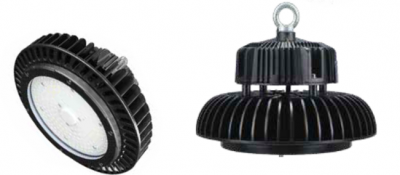
There are three advantages to be gained from replacing the entire fitting:
- the fittings are very flexible and come with optional motion sensors, daylight sensors, chains and wall brackets
- where more light is required, fittings can be combined in a ‘honeycomb’ array to increase light output
- new fittings are easy to upgrade serve as emergency lights.
LED light looks a lot brighter than the metal halide lamp and is interpreted differently by the eye. The wattage of an LED lamp is much lower than the wattage of a metal halide lamp equivalent light output.
Thus a 400W metal halide is typically replaced by a high quality 150W LED, and a 250W is replaced by a high quality 80W to 100W LED.
|
Metal halide bulb (W) |
Metal halide LED replacement (W) |
|
400W |
150W |
|
250W |
80W-100W |
Note that cheaper brands may be too weak for this relationship to hold; with all LEDs it is best to install quality fittings with lifetime expectations of 35-50,000 hours and good warranties.
Emergency lighting compliance
Warehouses tend to be big open spaces and thus under BS5622 Emergency Lighting (2016) they need to have emergency lighting throughout (not just at exits), generally requiring horizontal lighting of 0.5 lux at floor level.
Since the main emergency lighting standard was updated in 2016, we often find that commercial premises are not 100% compliant. Upgrading to LED lighting presents a good opportunity to achieve compliance as part of a cash positive project.
Upgrading to LED fittings (as opposed to retro-fitting corn bulbs) will enable you to make individual fittings into emergency lights. They will provide light off a battery pack when the power to the main lighting fails. We can model and test the level of lighting to ensure you are compliant with minimum levels.
Typical costs and payback time
The upgrade cost typically starts at £200+VAT (including installation costs) for a single 400W metal halide fitting. The actual cost will depend on the percentage of fittings that need to be emergency lights, access costs and other considerations such as whether the upgrade needs to be done out-of-hours.
Saving 250W per fitting for say 2,500 hours a year, will save 625kWh a year. At 12p per kWh, that’s worth £75 a year. Hence the 2-3 year payback time.
If you would like further information about upgrading your lights to LED, email us on info@spiritenergy.co.uk or request a quote:




